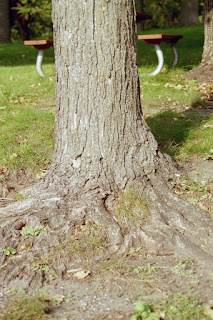I've moved on from rocks to forests in my studies. I didn't realize how many products came out of trees. Here's a quick listing: Adhesives, Carpeting, Cellophane, Chewing Gum, Cosmetics, Crayons, Erosion Control, Fences, Furniture, Imitation Leather, Lumber, Medicines, Mulch, Nuts and Fruits, Paper Products of All Sorts, Perfumes, Plywood, Printing Ink, Renewable Fuel, Syrup, Waxes,
Wind Breaks.
I dated a man in the late 70s, early 80s who was going to the University of Minnesota at the time for a program called "Forest Products Production Management." I really didn't understand what it was at the time, but I do now, especially after reading the latest chapter. I cannot stress how important fires actually are to a forest ecosystem. back in the day before humans stepped in. Back in the day, before humans stepped in, that was how forests renewed themselves. Now, many forest conservationists will let forests burn, unless it endangers buildings or humans. As my textbook states, "In fact, fires are integral to the continued health of many ecosystems because they clear out shrub and brush in the under-story, recycle nutrients, and keep species that depend on fire and the diverse mix that makes up our native forests. For example, the jack pine has cones that are so gooey with sap.. that they actually need a fire to heat up and "melt" the sap a bit so the cones scales can open and it's seeds escape. This is a strategy for the jack pine to keep it's seeds safe until the conditions are right for them to sprout and grow. Not so coincidentally, those conditions include abundant light and nutrients, which tend to be available after a fire"
Something else I didn't realize is that Dutch Elm Disease was actually a fungus. It was brought to the United States in shipments of logs from the Netherlands.
Although I already know about the Hinckley Fire of September 1, 1894, I didn't realize that it resulted from the combination of enormous amounts of what is called logging slash (prior to 1900, loggers left large amounts of tree debris, known as slash, to decompose in place), combined with an extremely hot and dry summer. According to the book the "... fire burned 266,000 acres, destroyed six towns, and killed more than 400 people."
During the summers spent growing up at Lake Jenie in central Minnesota, I spent a lot of time amongst the trees. Some of our neighbors out there would collect the sap from the maple trees and make homemade maple syrup. They would mark the trees in the fall with a brick so they would know which trees to go to in the spring. Some of the bricks are still by the trees even though the original owners are long gone. Our home base when playing softball was a big Basswood tree that just recently died of old age. Where our cabin was located is called Eagle Point because the clump of trees on the point once held an eagles nest. The clump was gone by the time I could remember. The corner posts of our cabin were rough-hewed logs. Tree houses were a part and parcel of my childhood.
Although I already know about the Hinckley Fire of September 1, 1894, I didn't realize that it resulted from the combination of enormous amounts of what is called logging slash (prior to 1900, loggers left large amounts of tree debris, known as slash, to decompose in place), combined with an extremely hot and dry summer. According to the book the "... fire burned 266,000 acres, destroyed six towns, and killed more than 400 people."
During the summers spent growing up at Lake Jenie in central Minnesota, I spent a lot of time amongst the trees. Some of our neighbors out there would collect the sap from the maple trees and make homemade maple syrup. They would mark the trees in the fall with a brick so they would know which trees to go to in the spring. Some of the bricks are still by the trees even though the original owners are long gone. Our home base when playing softball was a big Basswood tree that just recently died of old age. Where our cabin was located is called Eagle Point because the clump of trees on the point once held an eagles nest. The clump was gone by the time I could remember. The corner posts of our cabin were rough-hewed logs. Tree houses were a part and parcel of my childhood.
This is my backyard, South Park.
I've been taking pictures every fall of that burl, following its changes. It's a fungal infection.
The city started taking down so many trees, for various reasons, that I started taking pictures of what I call a tree's fingerprints, its roots.


A friend of mine, a Cree Indian Medicine Woman, taught me about the chief tree. She said it was usually much taller than the trees around it, for some distance. She said the chief tree is the heart of that area and when it dies the rest of the trees will begin to die as well. Scientists have since proven that trees have an interconnected system. https://www.cnn.com/2017/02/07/world/secret-life-of-trees/index.html She also taught me to watch the base of trees during late winter. She said when the snow starts melting away from the entire circumference of trunk, the trees are waking up and the big warm up would not be far away.
The tribes of South America believe the rainforests are the lungs of Mother Earth.
When I die I want to be cremated and my ashes placed in a BioUrn. https://urnabios.com/urn/ I want to be a tree. A vintage Cottonwood (I call them singing trees) perhaps, or a vintage Sugar Maple (Spring will always be sweet. ;) ) LOL
I love trees.







No comments:
Post a Comment